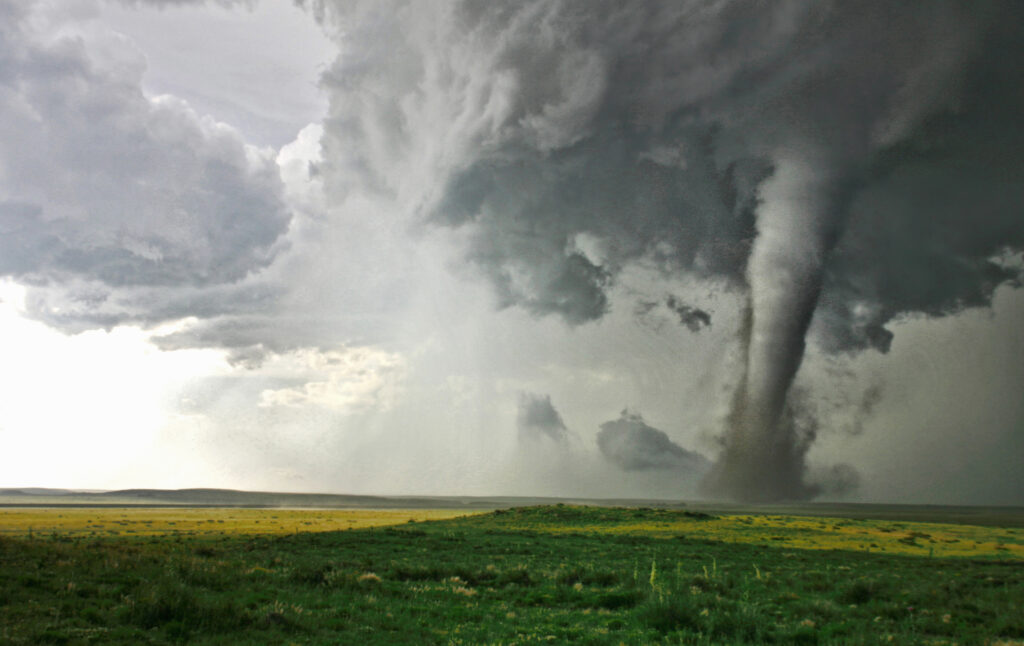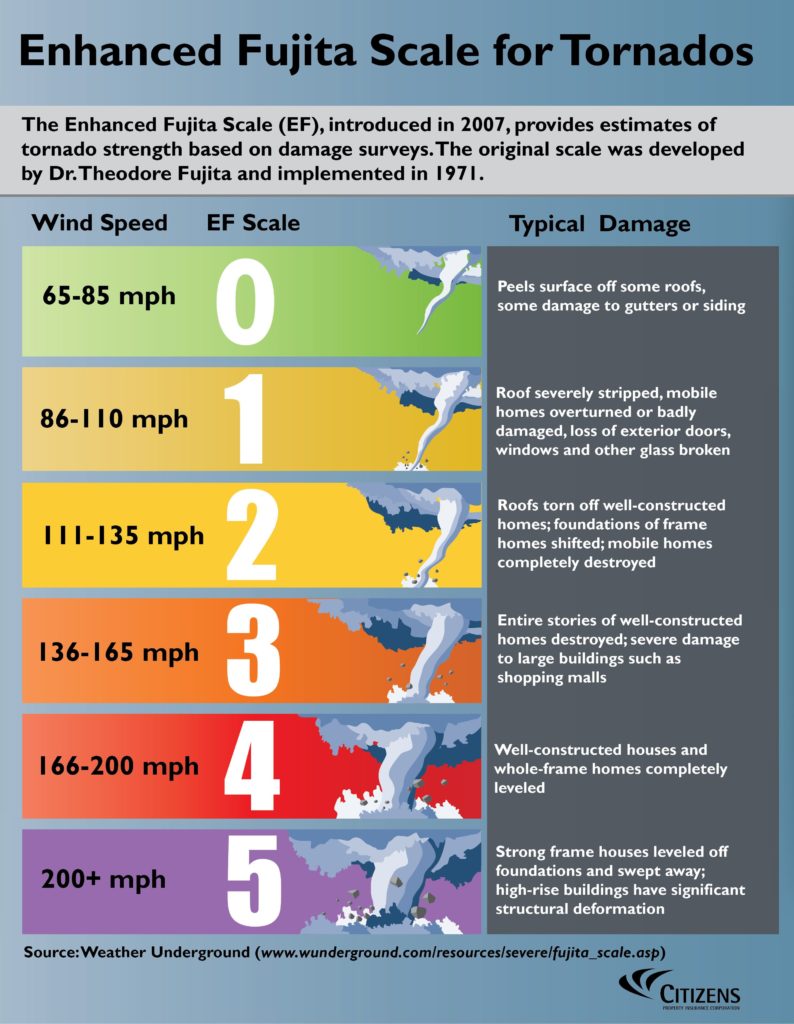
How Damage Determines a Tornado’s Rating: From Fujita to Enhanced Fujita
While storm chasers and engineers have developed vehicles and instruments capable of withstanding tornadoes, the intensity of tornadoes is primarily measured after their impact using the Enhanced Fujita Tornado Intensity Scale.
It is nearly impossible to measure the actual wind speed inside tornadoes as they can destroy just about any unprotected weather instruments placed in their path. While storm chasers and engineers have developed vehicles and instruments capable of withstanding tornadoes, the intensity of tornadoes is primarily measured after their impact using the Enhanced Fujita Tornado Intensity Scale (EF-scale).
The original Fujita Tornado Damage Scale, also known as the Fujita-Pearson Scale, was introduced in 1971 by Dr. Theodore Fujita, a severe storms researcher at the University of Chicago, in collaboration with Allen Pearson, then head of the National Severe Storms Forecast Center (now the Storm Prediction Center). The scale was named in honor of Dr. Fujita for his groundbreaking work in tornado intensity classification. Dr. Fujita’s scale, which ranges from F0 to F5, classified tornadoes by the type and severity of damage the tornado inflicted on human-built structures and vegetation.
The official Fujita Scale category was determined based on the following:

The Fujita Scale At a Glance
Fujita Tornado Intensity Scale
F-0: Gale tornado (40 – 72 mph). Light damage. Some damage to chimneys; branches broken off trees; shallow-rooted trees pushed over; sign boards damaged.
F-1: Moderate tornado (73 – 112 mph). Moderate damage. Peels surface off roofs; mobile homes pushed off foundations or overturned; moving autos blown off roads.
F-2: Significant tornado (113 – 157 mph). Considerable damage. Roofs torn off frame houses; mobile homes demolished; boxcars overturned; large trees snapped or uprooted; light-object missiles generated; cars lifted off ground.
F-3: Severe tornado (158 – 206 mph). Severe damage. Roofs and some walls torn off well-constructed houses; trains overturned; most trees in forest uprooted; heavy cars lifted off the ground and thrown.
F-4: Devastating tornado (207 – 260 mph). Devastating damage. Well-constructed houses leveled; structures with weak foundations blown away some distance; cars thrown and large missiles generated.
F-5: Incredible tornado (261 – 318 mph). Incredible damage. Strong frame houses leveled off foundations and swept away; automobile-sized missiles fly through the air in excess of 100 meters (109 yds); trees debarked; incredible phenomena will occur.
The Establishment of the Enhanced Fujita Scale
In subsequent years, structural engineers and meteorologists examined damage from many tornadoes. They used knowledge of the wind forces needed to damage or destroy various buildings and their components to estimate the resultant wind speeds. The engineers and scientists eventually determined that the original F-Scale wind speeds were greatly overestimated (too high) for categories F3 and higher.
In particular, homes are not constructed to withstand extreme winds of 250 to 300 mph. In many areas, building codes may only require roofs to endure winds up to 70 mph. Once a roof is torn off, the walls lose critical support, leading to structural failure. In other cases, the house frame may not be properly bolted to the foundation, it can then begin to slide off the foundation, perhaps partly lifted by strong upward winds in the tornado.
To read more about the creation of the first tornado-resistant building code, click here.
By the early 1990s, even Dr. Fujita recognized these shortcomings and recommended adjusting the assessments. Though each damage level is associated with a wind speed, the Fujita scale is essentially a damage scale, and the wind speeds associated with the damage listed are not rigorously verified. The Enhanced Fujita Scale was devised by a panel of meteorologists and wind engineers convened by the Wind Science and Engineering Research Center at Texas Tech University. On Feb. 1, 2007, the Fujita scale was decommissioned, and the more accurate EF-Scale was introduced in the U.S.
The meteorologists and engineers who designed the EF-scale believe it more accurately matches estimated wind speeds to the severity of related damage caused by the tornado and is an improvement on the F-scale on many counts:
- It accounts for different degrees of damage that occur with different types of structures, both man-made and natural.
- The expanded and refined damage indicators and degrees of damage descriptions standardize what was somewhat ambiguous.
- It is thought to provide a much better estimate for wind speeds and sets no upper limit on the wind speeds for the strongest level, EF-5.
- It better reflects examinations of tornado damage surveys to align wind speeds more closely with associated storm damage.
- The new scale has more to do with how most structures are designed.
Below is a brief description of the Enhanced Fujita Scale.
Enhanced Fujita Tornado Intensity Scale
EF-0: Light damage (65 – 85 mph). Peels surface off some roofs; some damage to gutters or siding; branches broken off trees; shallow-rooted trees pushed over. Original Fujita Scale estimated wind speeds: less than 73 mph.
EF-1: Moderate damage (86 – 110 mph). Roofs severely stripped; mobile homes overturned or badly damaged; loss of exterior doors; windows and other glass broken. Original Fujita Scale estimated wind speeds: 73 to 112 mph.
EF-2: Considerable damage (111 – 135 mph). Roofs torn off well-constructed houses; foundations of frame homes shifted; mobile homes completely destroyed; large trees snapped or uprooted; light-object missiles generated; cars lifted off ground. Original Fujita Scale estimated wind speeds: 113 to 157 mph.
EF-3: Severe damage (136 – 165 mph). Entire stories of well-constructed houses destroyed; severe damage to large buildings such as shopping malls; trains overturned; trees debarked; heavy cars lifted off the ground and thrown; structures with weak foundations blown away some distance. Original Fujita Scale estimated wind speeds: 158 to 206 mph.
EF-4: Devastating damage (166 – 200 mph). Whole frame houses Well-constructed houses and whole frame houses completely leveled; cars thrown and small missiles generated. Original Fujita Scale estimated wind speeds: 207 to 260 mph.
EF-5: Incredible damage (Over 200 mph). Strong frame houses leveled off foundations and swept away; automobile-sized missiles fly through the air in excess of 109 yards (100 meters); high-rise buildings have significant structural deformation; incredible phenomena will occur. Original Fujita Scale estimated wind speeds: 261 to 318 mph.
According to the National Weather Service, the EF-scale remains a system of wind estimates based on observed damage. It uses three-second gust estimates at the point of damage, determined by assessing eight levels of damage across 28 indicators. These indicators include 23 types of structures, such as barns, mobile homes and schools, as well as five additional objects like trees, towers and poles.
Wind speed estimates are then provided for each structure and type of damage. The three-second gust is not the same wind as in standard surface observations. Standard measurements are taken by weather stations in open exposures, using a directly measured, “one-minute mile” speed. Guidelines in the original scheme lumped together homes, schools, mobile homes, vehicles and trees in one short description of damage for each F-scale category.
To read more about how increased knowledge of tornado risks leads to better building codes, click here.
The National Weather Service is the only federal agency with the authority to provide “official” tornado EF-scale ratings. An EF-scale category is assigned based on the highest wind speed that occurred within the damage path.
When assessing tornado damage, trained National Weather Service personnel use one or more of the 28 designated damage indicators to evaluate the destruction. These indicators are matched to the type or construction of the building or structure in question. The observed damage is then aligned with one of the eight degrees of damage defined by the EF-scale.
A PDF file explaining the development and makeup of the EF-scale is available here
To learn more about tornado safety and recovery, click here.
The Fujita Scale had many problems arise when trying to evaluate areas affected by a tornado. Thus, the EF-scale was created to better correlate wind speed and damage to certain structures.
_Watch the latest video at foxnews.com







